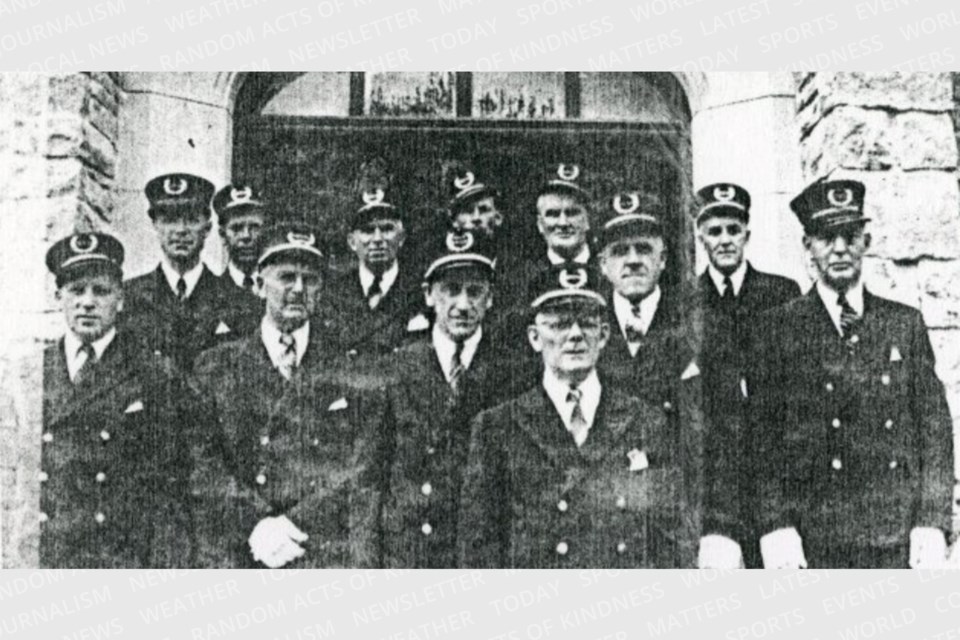In the spring of 1942, the news in Elora and Fergus was dominated by events of the war that had the entire world aflame. But in the early hours of May 1, the outbreak of fires right within the village limits of Elora alarmed the residents.
At about 2:30 in the morning, some people who were enjoying a late-night card party happened to look outside and saw flames on the property of their neighbour, Elwood M. Davidson, a cemetery superintendent and former Elora councillor and ex-chairman of the village relief committee.
Davidson’s stable was on fire. The neighbours immediately called in the alarm.
Chief John Cuthbert and the Elora Volunteer Fire Department hurried to the scene when they heard the siren. The blazing building was only three hundred yards (274 metres) from the firehall.
The second storey of the barn was an inferno but the firefighters were able to save the lower part of the structure thanks to strategically located water tanks.
Fortunately, no animals were in the barn.
With the fire thoroughly doused, the firemen went home. But that night’s excitement wasn’t over. At about 4 a.m. there was another alarm. This time the barn belonging to Arthur Main, currently an Elora councillor, was on fire.
Chief Cuthbert later told the press: “After the Davidson fire we filled the tank at the fire hall by pumping water from the river and I had just crawled into bed about 10 minutes when the second alarm sounded. We were at the Main fire almost three hours to make sure that nearby houses were not in danger. We ran out of water from the tank at the C.P.R. station and had to switch back to the fire hall tank before the blaze was extinguished.”
Like the fire on Davidson’s property, the one on Main’s property was close to the firehall, but it had been started at different locations in the barn, which meant that it engulfed the building more quickly.
The firemen were unable to save the structure, so it was lost along with most of what was in it: farming equipment, lumber and a large quantity of hay.
The fire fighters concentrated their efforts on preventing the flames from spreading to other buildings.
An electrical storm had passed over the area earlier that night, and it was suggested that lightning strikes could have started the fires. Chief Cuthbert scoffed at that idea. He said the fires had not been started by lightning, and that even if they had, the rain that accompanied the electrical storm would have put them out.
He suspected the fires had been the work of an arsonist, and hinted there could be a police investigation.
Three days later, the residents of Elora were stunned by news of yet another fire. This time it was the building that housed the municipal weigh scales and the town jail.
Aircraftman Harold Flewelling of the RCAF, home on leave from training at a base in St. Thomas, later told a reporter from the Guelph Mercury: “I was going to cut across the square behind the town hall on my way to my grandmother’s. I looked in that direction and there certainly was no fire at the weigh scales then. I walked down the street another couple hundred feet and stood talking before leaving my friends. I noticed the reflection of a fire in a nearby window. I thought it was a bonfire at first and didn’t pay too much attention. Then I saw it was the weigh scales and I ran to turn in the alarm.
“By the time I reached the fire the whole side of the building was ablaze. The flames seemed to be all over at once but not burning very deeply. It was only a matter of a couple of minutes until the place was like a furnace.”
The Elora volunteer firemen responded quickly. They managed to save part of the building, but there was fear the blaze could spread to two nearby garages and a barn owned by James Ross. A team of terrified horses was removed from the barn, though not without some difficulty.
Even before the flames were out, an even greater fear gripped Elora. Three suspicious fires within just a few days couldn’t be coincidental. Residents were concerned they had all been deliberately set.
An emergency meeting of the village council was called, and specially assigned constables were placed on duty to keep watch for the “pyromaniac.” The Toronto Globe & Mail reported on the possibility of a “fire-bug” at work in Elora.
The Ontario Provincial Police and the Ontario Provincial Fire Marshall began an investigation. They found Arthur Main had insured his barn for $200, but Elwood Davidson had no insurance on his property, so it did not appear that the fires had been part of a scheme to defraud insurance companies. The fact both men had been associated with the village council, and the weigh scales building was municipal property had investigators wondering if the mysterious arsonist was carrying out a vendetta against the community.
If that was indeed the case, the culprit did not commit any further acts of arson. Perhaps news of the official investigation and the presence of watchful constables discouraged them from starting more fires.
Whoever the Elora fire bug might have been, they were never caught.



